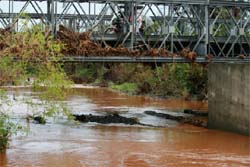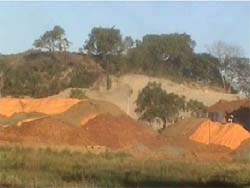Research on the Environmental Impact to Communities of On-going Large-Scale Mining Operations in Zambales Watersheds & Protected Areas and Identification of Community-Based Resource Management and Livelihood Alternatives
 |
Kilusan para sa Pambansang Demokrasya (KPD)-Philippines |
 |
Pete Pinlac |
 |
|
 |
JPY 400,000 |

Red soi from mining firms

A lot of soil and rocks
Research Background
Zambales is a province in the Philippines located in the Central Luzon region. It lies between the Zambales mountain range and the South China Sea. The Zambales mountains, including Mt. Pinatubo, are formed at the subduction of the Asian Plate at the Manila Trench. An exposed area of the ocean crust and mantle or OPHIOLITE is found in Zambales. It is what gives the province its heterogeneous geochemistry. Acoje and Coto block are the two different blocks found within the ophiolite. Coto block has become the world's largest producer of refractory chromite and a good source of platinum. On the other hand, nickel and metallurgical chromite, the biggest deposit in Asia, are in the Acoje block. Other non-metal resources that can be found in the province are sandstone, Zambales jade, serpentine, pumice, white clay, rock aggregate, salt stones, cobbles, boulders and silica quartz. Also found in the province are magnetite or black sand, copper, talc and gold. The province is blessed with rainforests rich in biodiversity. It is home to sixty three endemic plant species, fifty species of tropical hardwood, it produces prized orchids. Animals like monkeys, bats and rodents also abound. In its western seacoast a marine conservation with sea turtle nesting area and mangrove forests (Municipality of Masinloc) could be found. There are also declared protected areas such as the thirteen hectare Lake Malimanga Bird and Fish Sanctuary (Municipality of Candelaria), a thirteen hectare Game Refuge and Bird Sanctuary (Olongapo City), a three hundred hectare marine sanctuary where giant clams are raised (Municipality of Sta. Cruz) and the nine hectare Olongapo Naval Base Perimeter. The province is also home to Aetas, indigenous people whose communities could be found dotting the upland communities. In 1990's the Philippine government borrowed 27.5 Million pesos from the Asian Development Bank (ADB) to reforest five areas in Zambales. Sixty-seven percent of the total area or around a thousand hectares encompasses the Sta. Cruz Watershed. Now, due to the local government's tacit endorsement of mining operations (both large-scale and small scale), all five reforested areas are being mined without permit from the Department of Environment and Natural Resources (DENR).
There are more than thirty large scale mining firms currently operating in the province covering almost 83 thousand hectares of mountains and extracting an estimated five million metric tons of nickel laterite and metallurgical chromite. Also, armored rock and sand are the most quarried non-metal resources. It is estimated that such a volume of minerals would produce red dust a meter thick, sufficient to blanket the provincial highway from one end to another (Olongapo to Sta. Cruz). Some of the companies are Acoje Mining (chromite in Sta. Cruz),Benguet Corporation (chromite in Masinloc), Benguet -Dizon (gold in San Marcelino), NiHAO Mineral Resources International (nickel in Botolan) and A3UNA Mining Corporation. Notable are the following operations: Acoje nickel laterite, Guisguis nickel laterite, Coto Chromite Project and Mambog Nickel Laterite. These mining firms hold almost ninety percent of Zambales' mineral rich area.
Revenues from mining jumped from 3.3 million pesos in 2006 to sixty million pesos two years after, coinciding with blatant disregard of standing legislation governing Small Scale Mining Operations as well as Mining operations in general. Therefore, there are no requisite safeguards like catch basins, siltation, ponds or cover plants in any of the large-scale mining operation All the more disturbing is the trend that large mining firms are utilizing small mining operations as a means to mine more tracks of land for a fraction of the investment cost.
As a result, water source, agricultural land and forest areas are severely affected. Already, farmlands are inundated by raging blood-red flood waters and the beautiful marine sanctuary are in danger from the coast rimmed with blood-red water. Build-up of security forces in certain parts of the province as well as incidents of human rights violations are often associated with the continued operation of these large-scale mines. A situation so bad that prompted former provincial governor Amor Deloso compared the province to 'Iraq'.
An initial scanning of the large-scale mining operations in Zambales has pinpointed six municipalities which have significant large-scale mining operations. These are:
1. Cabangan - a 4th class municipality
2. Palauig - a third class municipality that includes the Philippine claimed EEZ Scarborough Shoal (Panatag Shoal)
3. Masinloc - a first class municipality
4. Candelaria - a 4th class municipality
5. Botolan - the largest municipality of Zambales and has a large Aeta population.
6. Sta. Cruz - a 2nd class municipality
These areas would be the focus of the study as they have been host to mining operations for more than a decade. In the case of Sta. Cruz, Acoje Mining has been extracting chromite since the 1930’s while Benguet Corporation has been mining chromite in Masinloc since 1934. The study will proceed to quantify the extent of the devastation wrought by large-scale mining on a socio-economic level for these municipalities. It will extensively document the economic effects as well as the environmental and social impact of such activities. And from the result of the research, it is expected that a viable and sustainable grass-roots resource management alternative would emerge.
[Sep. 2010]
Final Report (abstract)
The Philippine economic crisis is worsening. People could hardly afford prices of goods and services necessary for everyday living. Incomes are getting smaller while decent means of living are getting scarce. As social services have been greatly reduced, the ever-increasing taxes that the government, from the national down to the barrio level collects are like rubbing salt on people's wounds. For the people that have to crawl on their bellies to be able to pay their taxes, the barefaced corruption and plunder of the nation's treasury is an additional affront. And in the absence of genuine government concern for the people, it desperately resorts to a sell out of the country’s remaining natural resources. Now, more than ever, it is giving a boost to and stepping-up mining operations despite the grave tragedies brought about by the massive destruction of the environment. The government is hoping to earn the title, "Mining Capital of the World", as if this were an honorable title and could save the Philippines from economic crisis.
Zambales is one of the provinces identified as primary areas for carrying out big mining projects. Although an area rich in biodiversity and therefore should be protected by both the national and local governments, Zambales is one of the provinces that has long-suffered the ravages of mining activities. Due to the government's endorsement of mining operations (both large-scale and small scale), Zambales watersheds are being mined unhampered. Large scale mining firms currently dominate the mining industry in the province covering almost 83 thousand hectares of mountains and extracting an estimated five million metric tons of nickel laterite and metallurgical chromite. Also, armored rock and sand are the most quarried non-metal resources. These large mining firms are also utilizing small mining operations as a means to mine more tracks of land for a fraction of the investment cost. All in all, Zambales mining firms hold almost ninety percent of Zambales' mineral rich area.
Present scanning of large-scale mining operations in Zambales has pinpointed six municipalities which have significant large-scale mining operations:
(1) Cabangan-Botolan,
(2) Palauig-Masinloc and
(3) Candelaria-Sta.Cruz.
These areas contain the bulk of mining-related activities in the province. They also represent a rich diversity of natural resources that are currently under attack by continuous extractive activities. These areas are the focus of the research study conducted to evaluate the impact of unhampered mining activities in the province to people’s lives, livelihoods and the entire ecosystem.
In summary, the major points that were established during the entire research process and which the final research output contains are the following:
-Type of Mining Operation-
Massive Open Pit/Open Cut operations characterize the present operation in the province. This type covers large areas of land, uproots all trees, vegetation or crops, excavates and relocates large quantities of waste rocks for the purpose of extracting ore like nickel laterites or chromite.
The development of a new technology in mineral processing known as "Heap Leaching" gave a boost to the use of this method of mining. By employing this, even small particles of minerals like nickel in the subsoil can still be processed and extracted with minimum expenses and, therefore, ensure big profit.
-Mining Corporations -
At present, mining companies can be classified in terms of operation as:
(1) multinational and its subsidiaries;
(2) medium-scale and
(3) small-scale.
Around twenty-eight (28) big companies, largely multinational corporations or their subsidiaries, operate in the province. Owners of most of these companies are Australians and Chinese.
Forty-eight (48) small and medium-sized companies are in the province. The number reached 182 during the past administation. Most of these are subsidiaries of big foreign corporations that use "small-scale mining" as fronts to enable them to operate for the meantime that their big-time mining permits like the Mineral Production Sharing Agreement (MPSA) and the Financial or Technical Assistance Agreement (FTAA) are not yet aproved.
Estimates say that companies earn not lower that $5 million a year. The joint venture of Rusina and DMCI, for instance, had already earned $6.4 million during the first half of a year of its operations.
Among the local companies, the prominent ones are those owned by families that are well entrenched in government, if not close to the administration. Among them are the Defensors and the Romualdezes.
-Mineral Potential -
Estimated nickel reserves of Zambales are pegged at thirty-three million tons while chromite deposits are believed to be one of the world's largest. For example, Acoje laterites have been subject of a study by European Nickel that has confirmed a resource of 30.8 million tones at 1.12% nickel and 0.05% cobalt.
-Impact -
Open cut/ pit mining has appropriated hectares of agricultural and forest land (including watershed areas) into massive nickel and chromite pits. This includes ancestral domain claims by indigenous communities like the Aetas (specifically in Botolan).
Also, the operation which has displaced tons of waste rock and soil has enveloped the mining towns and nearby municipalities in red soil (red from the iron-rich sediments present) which turns into red mud when the rains come.
Soil erosion and landslides have been attributed to the mining activities.
Research data indicate that there are health-related problems from the red dust, laced with trace elements of nickel, cobalt, chromium and sulfuric acid, such as skin irritation, eye and respiratory problems.
Rivers, lakes and waterways have become shallow and water quality is also affected as soil and trace minerals settle at the bottom of such bodies of water.
The process of heap leaching has raised the question of environmental damage as residents fear that massive amounts of sulfuric acids could seep into the groundwater or spill out during a heavy downpour.
Sections of the population especially farmers, fisher folk as well as indigenous communities and their livelihoods had been displaced by the mining operations. Large areas were converted from agricultural use to industrial use to accommodate mining operations.
Another concern is the rise in human rights violations in areas where the mining firms are. Security forces have known to protect the interest of mining owners in the face of opposition to their operations be it individuals or whole communities.
The climate of fear in the communities is being insidiously maintained by such security forces, which serve the dual purpose of checking the opposition to the mining activities and at the same time allows for the continued operation of such mining firms inspite the public outcry against them.
[Dec. 2011]
Others
